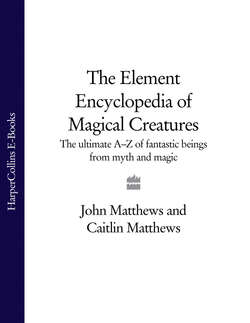Читать книгу The Element Encyclopedia of Magical Creatures: The Ultimate A–Z of Fantastic Beings from Myth and Magic - John Matthews - Страница 290
BUNYIP
ОглавлениеAccording to Australian aboriginal legend, the Bunyip (or Bunyee Bunyee) appear in many different forms. The most common features of all kinds are a horse-like tail, and flippers and tusks like those of a walrus. It inhabits swamps, creeks, lakes and billabongs. Like many Dreamtime animals, the Bunyip is fiercely antagonistic to human beings, and defends its home from invasion by devouring people at night. Its loud bellowing cry warns aboriginal people to avoid a water source if a Bunyip has his gunyah (home) within it.
Aboriginal legend tells how the Bunyip was created a man first of all but Biami, one of the wisest men created by Rainbow Serpent, had him banished from the tribe after he had eaten his own totem animal. Exiled and angry, Bunyip decided to make life unhappy for the tribes. Lurking in the gloom by day and hiding in deep waterholes, he emerged at night to bring terror to sleeping people, creeping up and devouring them. Some of the younger tribal women decided to test Bunyip’s alleged evil nature after being warned to avoid him, and they were trapped into becoming his slaves in the shape of water spirits, who helped lure people into the black waters of Bunyip’s gunyah. Like the Sirens, these water spirits had beautiful voices and would sing enticing songs to bring fresh prey to their master.
The hunter Goondah went fishing and landed a Bunyip cub. His fellow hunters bade him throw the cub back as they could hear the mother Bunyip bellowing and rising out of the water. But Goondah had promised meat for his girlfriend. He ran with the cub until he reached his sweetheart, but he was being followed by rising water drawn up by the mother Bunyip. Dropping the cub, he headed for a red gum tree, which he climbed with his girlfriend. As the water swirled higher, he looked down at his feet to see that they were feet no longer and that he, his sweetheart and friends had been turned into black swans.
The elders of a tribe wondered what had become of their young hunters, as they had not returned from hunting. On investigation, the elders found that the hunters’ tracks stopped at the edge of a lagoon. One elder dreamed that the missing men were held in a cave near the lagoon and a rescue was mounted. As he reached the far side of the lagoon, the elder discovered a cave entrance, but then two Bunyee Bunyee arose from the waters: four times the size of large dogs, covered with grey hair, with stumpy tails, four hooved legs, large teeth and tusks like a wild boar. The elder followed a line of footprints into the dark cave, stepping over many bones and there he found the missing hunters. They were grieved that he had been caught as well, but the elder had left instructions behind him, telling the rest of the rescue party to follow at a distance and listen well. With his yamstick he struck the ceiling of the cave until an answering sound of digging could be heard from above. A fishing net was passed down from above enabling the young men and their rescuer to be drawn up and escape from the devouring Bunyee Bunyees.
The white settlers of Australia perceived the Bunyip more as a herbivorous grazing animal, with a dog-like face and long shaggy coat, although some have been reported with a long-maned neck. Sightings of dog-faced Bunyips come largely from Victoria and Australian Capital Territory, as well as a few off Tasmania. One report of 1852 described the dog-faced Bunyip as about 4 ft long with a bulldog-like head and black shaggy fur, while another report describes it as being the size of a full-grown sheepdog but with two wing-like flippers. A long-necked Bunyip was seen in 1847 by settler George Hobler. He said that it was about the size of a six-month-old calf, brown with a long pointed head set on a long neck. It pricked up its large ears on sight of George. It had a thick mane of hair from head to neck and two large tusks. Its gait as it began to retreat was awkward and shambling. George noted that the forequarters of the animal were very much larger in proportion to the hindquarters, and that it had a large tail. On examining the tracks, they appeared to be broad and square, very like the print an outstretched human hand would make in the muddy ground.
The Bunyip is believed by some to be a form of extinct Australian marsupial, the diprotodon (Diprotodon australis), of rhinoceros size, that lived up until about 10,000 years ago and which may have survived as a kind of marsupial hippopotamus. Palaeon-tologists conjecture that the diprotodon may have had a dog-like face and a shaggy coat, both features of the Bunyip. Others have speculated that people saw a kind of seal or walrus that had adapted to inland waters. A recent Australian stamp was issued depicting the shaggy-coated, dog-faced Bunyip with scales on the upper part of its body, claws and a large tail.
